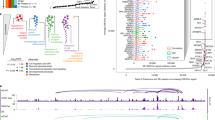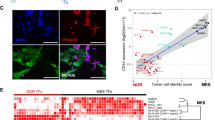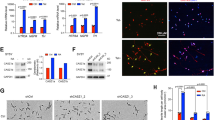Abstract
Neuroblastoma is a tumor of the peripheral sympathetic nervous system1, derived from multipotent neural crest cells (NCCs). To define core regulatory circuitries (CRCs) controlling the gene expression program of neuroblastoma, we established and analyzed the neuroblastoma super-enhancer landscape. We discovered three types of identity in neuroblastoma cell lines: a sympathetic noradrenergic identity, defined by a CRC module including the PHOX2B, HAND2 and GATA3 transcription factors (TFs); an NCC-like identity, driven by a CRC module containing AP-1 TFs; and a mixed type, further deconvoluted at the single-cell level. Treatment of the mixed type with chemotherapeutic agents resulted in enrichment of NCC-like cells. The noradrenergic module was validated by ChIP-seq. Functional studies demonstrated dependency of neuroblastoma with noradrenergic identity on PHOX2B, evocative of lineage addiction. Most neuroblastoma primary tumors express TFs from the noradrenergic and NCC-like modules. Our data demonstrate a previously unknown aspect of tumor heterogeneity relevant for neuroblastoma treatment strategies.
This is a preview of subscription content, access via your institution
Access options
Access Nature and 54 other Nature Portfolio journals
Get Nature+, our best-value online-access subscription
$29.99 / 30 days
cancel any time
Subscribe to this journal
Receive 12 print issues and online access
$209.00 per year
only $17.42 per issue
Buy this article
- Purchase on Springer Link
- Instant access to full article PDF
Prices may be subject to local taxes which are calculated during checkout




Similar content being viewed by others
Accession codes
References
Matthay, K.K. et al. Neuroblastoma. Nat. Rev. Dis. Primers 2, 16078 (2016).
Brodeur, G.M., Seeger, R.C., Schwab, M., Varmus, H.E. & Bishop, J.M. Amplification of N-myc in untreated human neuroblastomas correlates with advanced disease stage. Science 224, 1121–1124 (1984).
Mossé, Y.P. et al. Identification of ALK as a major familial neuroblastoma predisposition gene. Nature 455, 930–935 (2008).
Janoueix-Lerosey, I. et al. Somatic and germline activating mutations of the ALK kinase receptor in neuroblastoma. Nature 455, 967–970 (2008).
George, R.E. et al. Activating mutations in ALK provide a therapeutic target in neuroblastoma. Nature 455, 975–978 (2008).
Chen, Y. et al. Oncogenic mutations of ALK kinase in neuroblastoma. Nature 455, 971–974 (2008).
Peifer, M. et al. Telomerase activation by genomic rearrangements in high-risk neuroblastoma. Nature 526, 700–704 (2015).
Valentijn, L.J. et al. TERT rearrangements are frequent in neuroblastoma and identify aggressive tumors. Nat. Genet. 47, 1411–1414 (2015).
Saint-André, V. et al. Models of human core transcriptional regulatory circuitries. Genome Res. 26, 385–396 (2016).
Hnisz, D. et al. Super-enhancers in the control of cell identity and disease. Cell 155, 934–947 (2013).
Thomas, S. et al. Human neural crest cells display molecular and phenotypic hallmarks of stem cells. Hum. Mol. Genet. 17, 3411–3425 (2008).
Whyte, W.A. et al. Master transcription factors and Mediator establish super-enhancers at key cell identity genes. Cell 153, 307–319 (2013).
Ross, R.A., Spengler, B.A. & Biedler, J.L. Coordinate morphological and biochemical interconversion of human neuroblastoma cells. J. Natl. Cancer Inst. 71, 741–747 (1983).
Chipumuro, E. et al. CDK7 inhibition suppresses super-enhancer-linked oncogenic transcription in MYCN-driven cancer. Cell 159, 1126–1139 (2014).
Oldridge, D.A. et al. Genetic predisposition to neuroblastoma mediated by a LMO1 super-enhancer polymorphism. Nature 528, 418–421 (2015).
Rohrer, H. Transcriptional control of differentiation and neurogenesis in autonomic ganglia. Eur. J. Neurosci. 34, 1563–1573 (2011).
Pattyn, A., Morin, X., Cremer, H., Goridis, C. & Brunet, J.F. The homeobox gene Phox2b is essential for the development of autonomic neural crest derivatives. Nature 399, 366–370 (1999).
Flora, A. et al. SP proteins and PHOX2B regulate the expression of the human PHOX2a gene. J. Neurosci. 21, 7037–7045 (2001).
Lin, C.Y. et al. Active medulloblastoma enhancers reveal subgroup-specific cellular origins. Nature 530, 57–62 (2016).
Zhang, W. et al. Comparison of RNA-seq and microarray-based models for clinical endpoint prediction. Genome Biol. 16, 133 (2015).
Wakamatsu, Y., Watanabe, Y., Nakamura, H. & Kondoh, H. Regulation of the neural crest cell fate by N-MYC: promotion of ventral migration and neuronal differentiation. Development 124, 1953–1962 (1997).
Schramm, A. et al. Mutational dynamics between primary and relapse neuroblastomas. Nat. Genet. 47, 872–877 (2015).
Reiff, T. et al. Neuroblastoma Phox2b variants stimulate proliferation and dedifferentiation of immature sympathetic neurons. J. Neurosci. 30, 905–915 (2010).
Chapuy, B. et al. Discovery and characterization of super-enhancer-associated dependencies in diffuse large B cell lymphoma. Cancer Cell 24, 777–790 (2013).
Trochet, D. et al. Germline mutations of the paired-like homeobox 2B (PHOX2B) gene in neuroblastoma. Am. J. Hum. Genet. 74, 761–764 (2004).
Mosse, Y.P. et al. Germline PHOX2B mutation in hereditary neuroblastoma. Am. J. Hum. Genet. 75, 727–730 (2004).
Coppola, E., d'Autréaux, F., Rijli, F.M. & Brunet, J.-F. Ongoing roles of Phox2 homeodomain transcription factors during neuronal differentiation. Development 137, 4211–4220 (2010).
Ke, X.-X. et al. Phox2B correlates with MYCN and is a prognostic marker for neuroblastoma development. Oncol. Lett. 9, 2507–2514 (2015).
Garraway, L.A. & Sellers, W.R. Lineage dependency and lineage-survival oncogenes in human cancer. Nat. Rev. Cancer 6, 593–602 (2006).
Schleiermacher, G. et al. Combined 24-color karyotyping and comparative genomic hybridization analysis indicates predominant rearrangements of early replicating chromosome regions in neuroblastoma. Cancer Genet. Cytogenet. 141, 32–42 (2003).
Boeva, V. et al. Control-free calling of copy number alterations in deep-sequencing data using GC-content normalization. Bioinformatics 27, 268–269 (2011).
Etchevers, H. Primary culture of chick, mouse or human neural crest cells. Nat. Protoc. 6, 1568–1577 (2011).
Monterrubio, C. et al. Targeted drug distribution in tumor extracellular fluid of GD2-expressing neuroblastoma patient-derived xenografts using SN-38-loaded nanoparticles conjugated to the monoclonal antibody 3F8. J. Control. Release 255, 108–119 (2017).
Vassal, G. et al. Therapeutic activity of CPT-11, a DNA-topoisomerase I inhibitor, against peripheral primitive neuroectodermal tumour and neuroblastoma xenografts. Br. J. Cancer 74, 537–545 (1996).
Bettan-Renaud, L., Bayle, C., Teyssier, J.R. & Benard, J. Stability of phenotypic and genotypic traits during the establishment of a human neuroblastoma cell line, IGR-N-835. Int. J. Cancer 44, 460–466 (1989).
Langmead, B. & Salzberg, S.L. Fast gapped-read alignment with Bowtie 2. Nat. Methods 9, 357–359 (2012).
Ashoor, H. et al. HMCan: a method for detecting chromatin modifications in cancer samples using ChIP–seq data. Bioinformatics 29, 2979–2986 (2013).
ENCODE Project Consortium. An integrated encyclopedia of DNA elements in the human genome. Nature 489, 57–74 (2012).
Lovén, J. et al. Selective inhibition of tumor oncogenes by disruption of super-enhancers. Cell 153, 320–334 (2013).
Rao, S.S.P. et al. A 3D map of the human genome at kilobase resolution reveals principles of chromatin looping. Cell 159, 1665–1680 (2014).
Herrmann, C., Van de Sande, B., Potier, D. & Aerts, S. i-cisTarget: an integrative genomics method for the prediction of regulatory features and cis-regulatory modules. Nucleic Acids Res. 40, e114 (2012).
Medina-Rivera, A. et al. RSAT 2015: Regulatory Sequence Analysis Tools. Nucleic Acids Res. 43 (W1), W50–W46 (2015).
Wiederschain, D. et al. Single-vector inducible lentiviral RNAi system for oncology target validation. Cell Cycle 8, 498–504 (2009).
Franken, N.A.P., Rodermond, H.M., Stap, J., Haveman, J. & van Bree, C. Clonogenic assay of cells in vitro. Nat. Protoc. 1, 2315–2319 (2006).
Acknowledgements
We are grateful to M. Ponzoni (IRCCS Istituto Giannina Gaslini), M. Schwab (German Cancer Research Center), J. Couturier (Institut Curie) and R. Versteeg (University of Amsterdam) for providing neuroblastoma cell lines. We thank F. Tirode and C. Kamoun for help with RNA-seq analysis and alignment of NGS data, respectively; O. Blanchard for help in cell culture experiments; and M. Caly for PHOX2B immunohistochemistry. We are grateful to the animal facilities team, the Experimental Pathology Department and the Plateforme Génomique of Institut Curie. We thank N. Clément, T. Adam-de-Beaumais and B. Mallon for their help in the identification of neuroblastoma diagnosis–relapse pairs and V. Bernard for pairs validation. We thank V. Saint-André for scientific discussion, J. Maliash-Planchon and the Unité de Génétique Somatique for preparation of patient samples. We thank D. Figarella-Branger (BB-033-00097, CRB AP-HM, CRB TBM, AC-2013-1786), M. Clapisson (CRB Centre Léon Bérard, AC-2008-101), O. Minckes, C. Blanc-Fournier and N. Rousseau (CHU, Tumorothèque de Caen Basse Normandie) for providing tumor patient samples. This work was supported by grants from Institut Curie, INSERM, the Ligue Nationale contre le Cancer (Equipe Labellisée), the Société Française de Lutte contre les Cancers et les Leucémies de l'Enfant et l'Adolescent, the Institut National du Cancer (PRT-K14-061 and PHRC IC 2007-2009) and by the following associations: Association Hubert Gouin “Enfance and Cancer,” Les Bagouz à Manon, les amis de Claire, Courir pour Mathieu, Dans les pas du Géant and Olivier Chape. The MAPPYACTS protocol is supported by the Institut National du Cancer (PHRC-K14-175), the Fondation ARC (MAPY201501241), the Société Française de Lutte contre les Cancers et les Leucémies de l'Enfant et l'Adolescent (Fondation Enfants et Santé), the Fondation AREMIG and the Association Thibault BRIET. High-throughput sequencing was performed by the ICGex NGS platform of the Institut Curie, supported by the grants ANR-10-EQPX-03 (Equipex) and ANR-10-INBS-09-08 (France Génomique Consortium) from the Agence Nationale de la Recherche (Investissements d'Avenir program); by the Canceropole Ile-de-France; and by the SiRIC-Curie program -SiRIC Grant INCa-DGOS- 4654. Biomark analysis was done using the High Throughput qPCR-HD-Genomic Paris Centre platform supported by grants from Région Ile-de-France (21016711). G.S. is supported by the Annenberg Foundation (11-385). V.B. is supported by the ATIP-Avenir Program, the ARC Foundation (ARC-RAC16002KSA-R15093KS), Worldwide Cancer Research (WCR16-1294 R16100KK) and the “Who Am I?” Laboratory of Excellence ANR-11-LABX-0071, funded by the French Government through its Investissement d′Avenir program, operated by the French National Research Agency (ANR) (ANR-11-IDEX-0005-02). H.R. is supported by the Mayent-Rothschild program from Institut Curie and the Wilhelm-Sander-Stiftung. The laboratory of T.G.P.G. is supported by LMU Munich's Institutional Strategy LMUexcellent within the framework of the German Excellence Initiative, the Mehr LEBEN für krebskranke Kinder—Bettina-Bräu-Stiftung, the Walter Schulz Foundation, the Wilhelm-Sander-Stiftung (2016.167.1) and the German Cancer Aid (DKH-111886 and DKH-70112257).
Author information
Authors and Affiliations
Contributions
V.B. and I.J.-L. conceived the study, analyzed the data and wrote the manuscript. V.B. coordinated bioinformatics analysis and I.J.-L. coordinated the whole study. C.L.-B. performed in vitro experiments and ChIP experiments and participated in the study design. A.P. generated and analyzed the doxycycline-inducible anti-PHOX2B shRNA cell lines. S.D. performed the single-cell analysis and study of chemotherapeutic agents. C.P.-E. performed the in vivo experiments and contributed in vitro experiments. V.R. performed all sequencing experiments. H.C.E. and S.T. provided hNCC cell lines and V.C. provided neuroblastoma cell lines. A.L. performed alignment of RNA-seq and ChIP-seq data. E.D.-D., B.G., D.S. and A.M.C. provided neuroblastoma PDXs. I.M. performed the reproducibility analysis. E.D. and B.D. generated the Biomark data. M.F.O. and T.G.P.G. generated lentiviral particles and provided help with lentiviral infections. S.B. coordinated and supervised sequencing experiments. G.S. participated in the study design and provided the in-house pairs of diagnosis–relapse samples with the help of E.L., G.P. and B.G. S.G.-L. participated in RNA-seq analysis. E.B. provided computational infrastructure and data storage. H.R. and T.D. provided expertise in sympathetic nervous development and TFs. I.J.-L. and O.D. provided laboratory infrastructure. I.J.-L., V.B. and O.D. provided financial support. All authors read and approved the final manuscript.
Corresponding authors
Ethics declarations
Competing interests
The authors declare no competing financial interests.
Supplementary information
Supplementary Text and Figures
Supplementary Figures 1–22, Supplementary Tables 1, 2 and 7 and Supplementary Note. (PDF 3758 kb)
Supplementary Table 3
Characteristics of neuroblastoma and hNCC super-enhancers. Group I: all neuroblastoma cell lines with the exception of SH-EP, GIMEN, GICAN, SK-N-AS, SJNB12, SK-N-SH and CHP-212. Group II: SH-EP, GIMEN and GICAN. (XLSX 1059 kb)
Supplementary Table 4
Supervised analysis of super-enhancer (SE) scores according to MYCN status. (XLSX 22 kb)
Supplementary Table 5
Supervised analysis of super-enhancer (SE) scores according to ALK status. (XLSX 20 kb)
Supplementary Table 6
Raw Ct values measured for housekeeping genes (GAPDH, ACTG1, ACTB, RPL15) and TFs of modules 1 and 2 for single cells of the SK-N-AS, SH-EP, SH-SY5Y and SK-N-SH cell lines using the Fluidigm Biomark HD. (XLSX 58 kb)
Rights and permissions
About this article
Cite this article
Boeva, V., Louis-Brennetot, C., Peltier, A. et al. Heterogeneity of neuroblastoma cell identity defined by transcriptional circuitries. Nat Genet 49, 1408–1413 (2017). https://doi.org/10.1038/ng.3921
Received:
Accepted:
Published:
Issue Date:
DOI: https://doi.org/10.1038/ng.3921
This article is cited by
-
Identification of MYCN non-amplified neuroblastoma subgroups points towards molecular signatures for precision prognosis and therapy stratification
British Journal of Cancer (2024)
-
Targeting the myeloid microenvironment in neuroblastoma
Journal of Experimental & Clinical Cancer Research (2023)
-
IGF2BP1 induces neuroblastoma via a druggable feedforward loop with MYCN promoting 17q oncogene expression
Molecular Cancer (2023)
-
CRISPR/Cas9-based genome-wide screening of the deubiquitinase subfamily identifies USP3 as a protein stabilizer of REST blocking neuronal differentiation and promotes neuroblastoma tumorigenesis
Journal of Experimental & Clinical Cancer Research (2023)
-
Etiology of super-enhancer reprogramming and activation in cancer
Epigenetics & Chromatin (2023)



